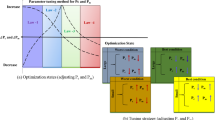Abstract
A compact and low-voltage CMOS exponential function generator circuit based on a new pseudo-approximation method is designed in 180-nm CMOS standard technology. The proposed approximation method is based on the TLBO evolutionary algorithm and shows a close characteristic to the ideal exponential function behavior over wide input range. Simulation results using HSPICE validate the theoretical analysis and verify the efficiency of proposed circuit which shows more than 66 dB output dynamic voltage range while the error is less than \({\pm }0.5\,\hbox {dB}\). The total power consumption is below 0.17 mW with a \({\pm }0.75\,\hbox {V}\) power supply.









Similar content being viewed by others
References
K.M. Abdelfattah, A.M. Soliman, Variable gain amplifiers based on a new approximation method to realize the exponential function. IEEE Trans. Circuits Syst. I Fundam. Theory Appl. 49(9), 1348–1354 (2002)
K.M. Al-Tamimi, M.A. Al-Absi, A 6.13 \(\upmu \)W and 96 dB CMOS Exponential Generator. IEEE Trans. Very Large Scale Integr. (VLSI) Syst. 22(11), 2440–2445 (2014)
T. Arthansiri, V. Kasemsuwan, Current-mode pseudo-exponential-control variable-gain amplifier using fourth-order Taylor’s series approximation. Electron. Lett. 42(7), 379380 (2006)
C.-C. Chang, S.-I. Liu, Current-mode pseudo-exponential circuit with tunable input range. Electron. Lett. 36(16), 1335–1336 (2000)
Q.-H. Duong, T.-K. Nguyen, S.-G Lee, dB-linear VI converter with tunable input and output range, in IEEE 46th Midwest Symposium on Circuits and Systems, 2003 (IEEE, 2003), pp. 201–204
Q.-H. Duong, T.K. Nguyen, S.-G. Lee, CMOS exponential current-to-voltage circuit based on newly proposed approximation method, in ISCAS’04. Proceedings of the 2004 International Symposium on Circuits and Systems 2004, vol. 862 (IEEE, 2004), pp. II-865–868
B. Ghanavati, A. Nowbakht, \({\pm }\)1V high frequency four quadrant current multiplier. Electron. Lett. 46(14), 974–976 (2010)
V. Kalenteridis, S. Vlassis, S. Siskos, 1.5-V CMOS exponential current generator. Analog Integr. Circuits Signal Process. 72(2), 333–341 (2012)
C.-H. Kao, W.-P. Lin, C.-S. Hsieh, Low-voltage low-power current mode exponential circuit. IEE Proc. Circuits Dev. Syst. 152(6), 633–635 (2005)
M.-L. Lin, A.T. Erdogan, T. Arslan, A. Stoica, A novel CMOS exponential approximation circuit, in SOC Conference, 2008 IEEE International (IEEE, 2008), pp. 301–304
W. Liu, S.-I. Liu, CMOS exponential function generator. Electron. Lett. 39(1), 1–2 (2003)
W. Liu, C.-C. Chang, S.-I. Liu, Realisation of exponential VI converter using composite NMOS transistors. Electron. Lett. 36(1), 8–10 (2000)
W. Liu, S.-I. Liu, S.-K. Wei, CMOS current-mode divider and its applications. IEEE Trans. Circuits Syst. 2 Express Briefs 52(3), 145–148 (2005)
D. Moro-Frias, D. La Cruz-Blas, M. Sanz-Pascual, PWL current-mode CMOS exponential circuit based on maximum operator. IEEE Trans. Circuits Syst. II Express Briefs 62(12), 1169–1173 (2015)
C.R. Popa, Low-voltage CMOS current-mode exponential circuit with 70 dB output dynamic range. Microelectron. J. 44(12), 1348–1357 (2013)
R.V. Rao, V.J. Savsani, D. Vakharia, Teaching-learning-based optimization: a novel method for constrained mechanical design optimization problems. Comput. Aid. Des. 43(3), 303–315 (2011)
B. Razavi, Design of Analog CMOS Integrated Circuits (McGraw-Hill, New York, 2001)
S. Vlassis, CMOS current-mode pseudo-exponential function circuit. Electron. Lett. 37(8), 471–472 (2001)
Author information
Authors and Affiliations
Corresponding author
Rights and permissions
About this article
Cite this article
Ghanavati, B., Abiri, E. & Salehi, M.R. A High-Accurate Exponential Function Generator Based on a New Pseudo-Approximation Method by TLBO Optimization Algorithm. Circuits Syst Signal Process 37, 1407–1421 (2018). https://doi.org/10.1007/s00034-017-0625-3
Received:
Revised:
Accepted:
Published:
Issue Date:
DOI: https://doi.org/10.1007/s00034-017-0625-3




